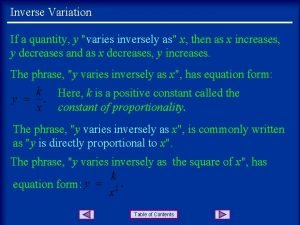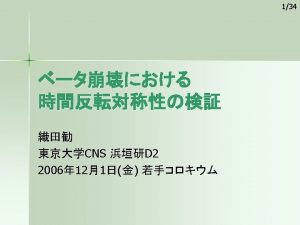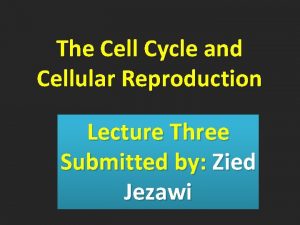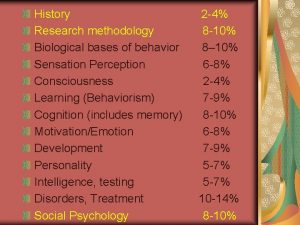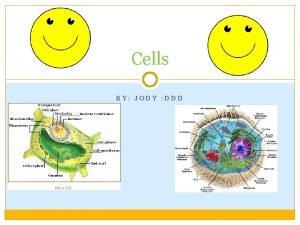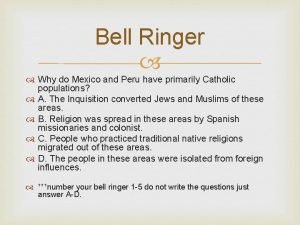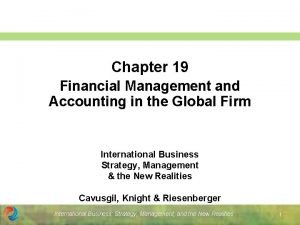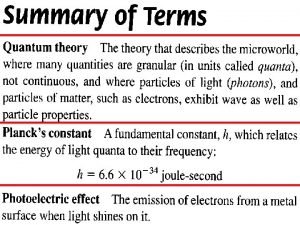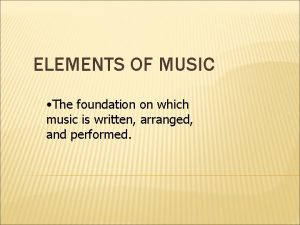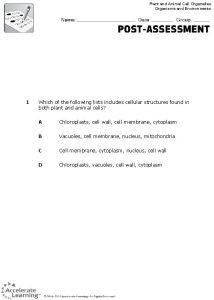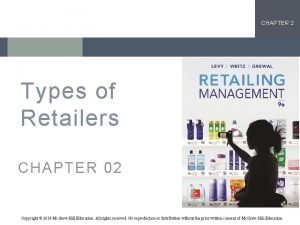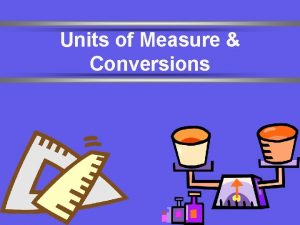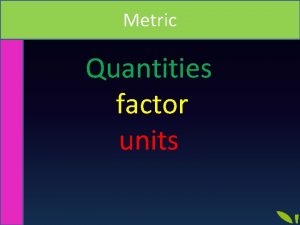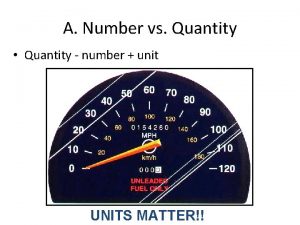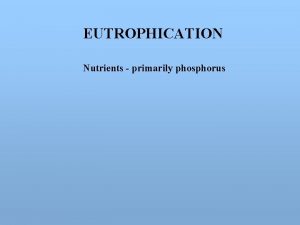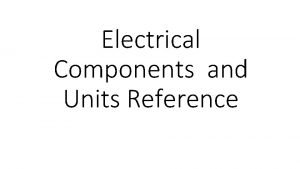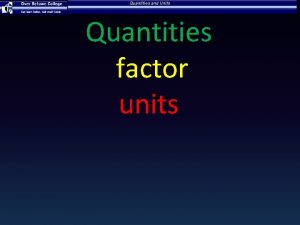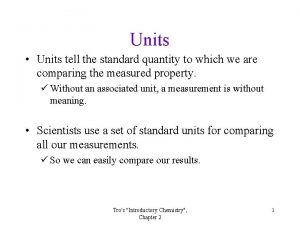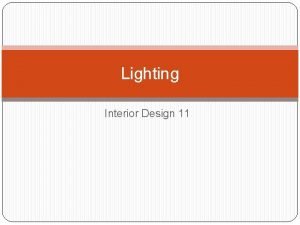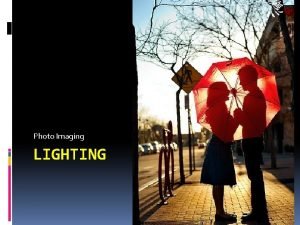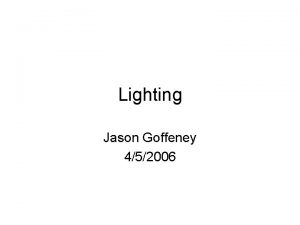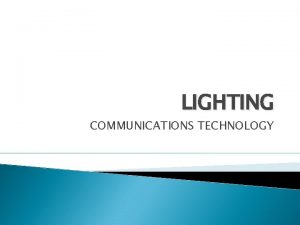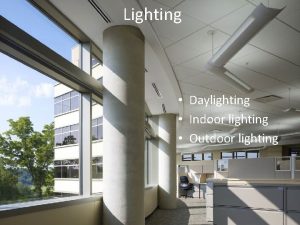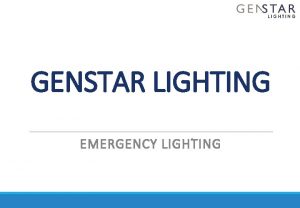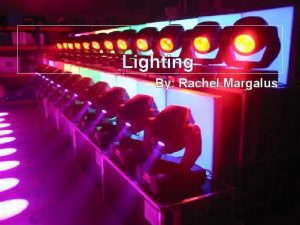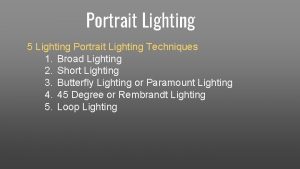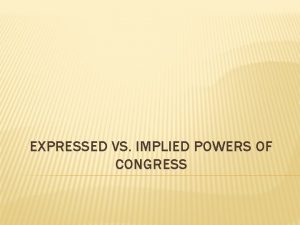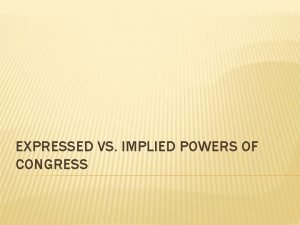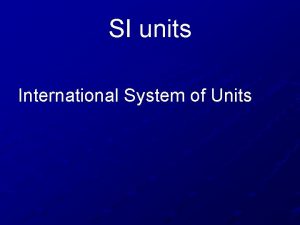Lighting Efficiency Units Lighting quantity is primarily expressed
























- Slides: 24

Lighting Efficiency

Units • Lighting quantity is primarily expressed in three types of units. § Watts – measure of electrical power that defines the rate of energy consumption. § Lumens – output of a lamp, how much light is being produced by the lighting system. § Foot candles – shows how much light is actually reaching the work plane or task (lumens/Sq. Ft)

Light Levels***

Factors in successful Lighting Applications Amount of light required in FC Efficacy* Lumen output of lamps and fixtures Color rendition – Color Rendering Index (CRI) • Color temperatures in Kelvin • Types of light source • Lighting Quality • •

• Efficacy – similar to efficiency, efficacy describes an output/input ratio, the higher the output (while input is kept constant) the greater the efficacy. Measured as lumens/watt.

Color Rendition (CRI) Indicates the effect of a light source on the color appearance of objects for a given color temperature. 75 - 100 CRI = Excellent color rendition 65 – 75 CRI = Good color rendition 55 – 65 CRI = Fair color rendition 0 – 55 CRI = Poor color rendition

Color Temperature A measure of the “warmth” or “coolness” of a light source. Also effects color appearance of objects. < 3, 200 K = warm or red side of spectrum >4, 000 K = cool or blue side of spectrum

Amount of light required for specific applications We often use more light than is needed for many applications and tasks. Light levels are measure in foot-candles using an luminance meter. FC = lumens/Sq. Ft Consensus standards for light levels are set by the Illuminating Engineering Society of North America (IESNA. org).

Lighting Maintenance Principles • Light output of all lighting systems decreases over time Philips • Lighting systems are over-designed to compensate for future light loss • Improving maintenance practices can reduce light loss and can either: – Allow reductions in energy consumption, or – Improve light levels • Group maintenance practices save money

What to look for in Lighting Audit • • • Lighting Equipment Inventory Lighting Loads Room dimensions Illuminating levels Hours of Use Lighting Circuit Voltage

Potential Lighting ECMs • • • Fluorescent Upgrades Delamping Incandescent Upgrades HID Upgrades Controls Upgrades Daylight compensation (daylight harvesting)

Three major areas for lighting improvement Much of the cost savings from new retrofit lighting can be achieved in three major areas: 1. Replace incandescent lamps with fluorescent or CFLs 2. Upgrade fluorescent fixtures with improved components 3. Install lighting controls to minimize energy costs

Not all lighting needs to be changed • Lowering lights can also yield great results with existing lighting where feasible and possible. • Fundamental Law of Illumination (or Inverse Square Law) • E = Illuminance in Foot Candles • I = Luminous intensity in lumens • d = Distance from light source to surface area of interest Let’s look at an example:

Another method: A high bay facility has their lights located at a height of 40’, there is no use of the space between 20’ and 40’. The current light levels are 50 FC at the floor. What will the approximate FC be if lowering the lights to the 20’ level? Answer:


Energy Savings Potential with Occupancy Sensors Offices (private) Offices (open spaces) Rest Rooms Corridors Storage Areas Meeting Rooms Conference Rooms Warehouses 25 – 50% 20 – 25% 30 – 75% 30 – 40% 45 – 65% 50 – 75%

Lighting Example: Assumptions – 1. 2. 3. 4. 5. 6. 2 x 4 troffer with 4 lamps Average energy cost = $0. 07/k. Wh Annual fixture operation = 3, 500 hrs. Lamp life = 28, 860 hrs. Labor to replace lamps = $6. 00/lamp System life = 15 years A. Case “A” – fixture power = 144 W lamp cost = $1. 50 each B. Case “B” – fixture power = 101 W lamp cost = $3. 00 each Find the following: AEC (Annual Energy Cost) AMC ( Annual Material Cost) ALC (Annual Labor Cost) AOC (Total Annual Operating Cost)

Lighting Example Solution: AEC = Fixture Power (k. W) x Operation (hrs/yr) x energy cost ($/k. Wh) AEC (A) = _____ AEC (B) = _____ AMC = lamps/yr x cost ($/lamp) AMC (A) = _____ AMC (B) = _____ ALC = lamps/yr x labor ($/lamp) ALC (A) = _____ ALC (B) = _____ AOC = AEC + AMC + ALC AOC (A) = _____ AOC (B) = _____ *lamps/yr = # of lamps x (operation (hrs/yr)/Lamp life (hrs/lamp))

High Bay cost analysis: A 244, 000 Sq. Ft high bay facility is presently lit with 800 twin 400 W mercury vapor fixtures (455 watts per lamp including ballast). What are the annual savings of replacing the existing lighting system with 800 single 400 W high pressure sodium fixtures (465 watts per lamp including ballast)? Assume 8, 000 hrs. operation per year, an energy cost of $0. 05/k. Wh, and a demand cost of $6. 00/k. W per month. Solution is …………………. .

………but first let’s look at a couple of things. What does a ballast do? - Conditions the lamp to start - Applies a high voltage spike to start the gas discharge process - Applies a current limiter to reduce the lamp current to a safe operating level What is Demand Charge? - Let’s look at the handout. ………now let’s look at the answer……. .

• Old System Incandescent hallway recessed downlighting in 12’ hallway. 100 fixtures @ 75 watts. 15 hrs/day operating hours, 6 days a week (4, 680 hrs. /yr. ). • New System Screw-in fluorescent lamps (82 CRI) with integrated magnetic ballasts, downlighting reflectors. 100 fixtures @ 22 watts (including ballast operation). • Results 71 % energy savings, virtually unchanged light level and appearance. 10 times longer lamp life. • Savings • k. W savings – Difference between Fixture “A” times kw/fixture and Fixture “B” times kw/fixture k. Wh savings – k. W times # of operating hours/year Demand $ savings – k. W times demand charge times months in a year Energy $ savings – k. Wh times energy rate charge Total dollar savings – add dollar savings together

T 8 Example Old System Office lighting consisting of 360 fluorescent 2’ x 4’ fixtures. Operating hours are 14 hrs/day, 5 days a week (3, 640 hrs/yr). Each fixture draws 188 watts with 4 standard cool white 40 watt fluorescent lamps and 2 standard magnetic ballasts. $4 k. W monthly demand charge. Energy rate is $0. 08/k. Wh. New System Each fixture now draws 112 watts with 4 tri-phosphor F 40 T 8 32 watt fluorescent lamps and 1 electronic T-8 instant-start mode ballast. Material costs are $612/yr and labor costs are $437/yr Results 40% energy savings, 2% reduction in light level, improved color rendering, 50% fewer ballasts to replace, 25% less lamp life using instant-start mode ballasts. Savings k. W saving = ? k. Wh savings = ? Demand savings = ? Energy Savings = ? Total dollar savings = ?

• Cost of Material: 1440 F 40 T 8 fluorescent lamps @ $3. 25 ea. ; 360 T-8 instant-start mode electronic ballasts @ $31 ea. ; labor to install 360 fixtures @ $20 ea. Total project cost: $23, 040 • Payback $23, 040 / $9, 29508/yr = 2. 5 years

• One more thing to remember: The amount of carbon dioxide greenhouse gas generated during electricity production ranges from 1. 4 lbs. to 2. 8 lbs per k. Wh. Depending upon the production method used, coal, nuclear, or hydro power this also needs to be accounted for when considering the environment.
 Distance is scalar quantity why
Distance is scalar quantity why Vary inversely
Vary inversely Difference between vector and scalar
Difference between vector and scalar Scalar vector tensor
Scalar vector tensor Scalar and vector quantities
Scalar and vector quantities Allocative efficiency and productive efficiency
Allocative efficiency and productive efficiency Productively efficient vs allocatively efficient
Productively efficient vs allocatively efficient Allocative efficiency vs productive efficiency
Allocative efficiency vs productive efficiency Variable costing income statement
Variable costing income statement Botox crow's feet injection sites
Botox crow's feet injection sites Guillaume de machaut worked primarily in
Guillaume de machaut worked primarily in Cell in interphase labeled
Cell in interphase labeled Scope of humanities in art appreciation
Scope of humanities in art appreciation According to john watson behavior is governed primarily by
According to john watson behavior is governed primarily by Small grain like body made primarily of rna
Small grain like body made primarily of rna Edward jenner’s innovation helped to
Edward jenner’s innovation helped to Multilateral netting is used primarily to
Multilateral netting is used primarily to Light behaves primarily as a particle when it
Light behaves primarily as a particle when it Elements of music
Elements of music Animal cells
Animal cells Type of retailer
Type of retailer Business ethics deals primarily with
Business ethics deals primarily with Deciduous forests are found primarily in africa.
Deciduous forests are found primarily in africa. What is zone control system in driving
What is zone control system in driving Complex carbohydrates are found primarily in ____.
Complex carbohydrates are found primarily in ____.

